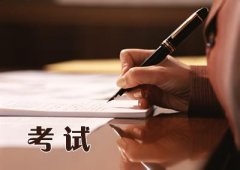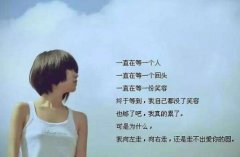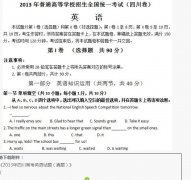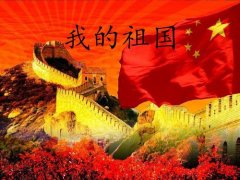2006-2013年高考英语四川卷(37)
B. a teacher who teaches story writing in university
C. a researcher who studies the way humans think and act
D. a professor who helps organizations make important decisions
54. According to James March, experience ______________.
A. is overvalued B. is easy to explain
C. should be actively sought D. should be highly respected
55. What can we learn from Paragraph 3?
A. Experience makes stories more accurate.
B. Stories made interesting fail to fully present the truth.
C. The use of stories is the best way of experiential learning.
D. Stories are easier to understand when reality is more accurately described.
56. What’s the purpose of this text?
A. To introduce a book. B. To describe a researcher.
C. To explain experiential learning. D. To discuss organizational decision making.
E
In business, there is a speed difference: It’s the difference between how important a firm’s leaders say speed is to their competitive (竞争的) strategy(策略)and how fast the company actually moves. The difference is important regardless of industry and company size. Companies fearful of losing their competitive advantage spend much time and money looking for ways to pick up the speed.
In our study of 343 businesses, the companies chose to go, go, go to try to gain an edge ended up with lower sales and operating incomes than those that paused at key moments to make sure they were on the right track, What’s more ,the firms that “slowed down to speed up” improved their top and bottom lines , averaging 40% higher sales and 52% higher operating incomes over a three-year period.
How did they disobey the laws of business physics, taking more time than competitors yet performing better? They thought differently about what “slower” and “faster” mean. Firms sometimes fail to understand the difference between operational speed (moving quickly )and strategic speed (reducing the time it takes to deliver value ).Simply increasing the speed of production, for example ,may be one way to try to reduce the speed difference .But that often leads to reduced value over time, in the form of lower-quality products and services.
In our study, higher performing companies with strategic speed always made changes when necessary. They became more open to ideas and discussion. They encouraged new ways of thinking. And they allowed time to look back and learn. By contrast (相比而言) performance suffered at firms that moved fast all the time. Pad too much attention to improving efficiency, stuck to tested methods,didn’t develop team spirit among their employees ,and had little time thinking about changes.
Strategic speed serves as a kind of leadership. Teams that regularly take time to get things right , rather than plough ahead full bore , are more successful in meeting their business goals . That kind of strategy must come from the top.
57 . What does the underlined part “gain an edge “in Paragraph 2 mean?
A. Increase the speed. B. Get an advantage. C. Reach the limit. D. Set a goal.
58. The underlined part “the laws of business physics” in Paragraph 3 means ___________.
A. spending more time and performing worse. B. spending more time and performing better
C. spending less time and performing worse D. spending less time and performing better
59. What can we learn from the text?
A. How fast a firm moves depends on how big it is.
B. How competitive a firm is depends on what it produces.
C. Firms guided by strategic speed take time to make necessary changes.
D. Firms guided by operational speed take time to develop necessary team spirit.
60. Where could be the best title for the text?
A. Improve quality? Serve better. B. Deliver value? Plough ahead.
C. Reduce time? Move faster. D. Need speed? Slow down.
第二节 根据对话内容,从对话后的选项中选出能填入空白处的最佳选项,并在答题卡上将该项涂黑。选项中有两项多余选项。(共5小题:每小题2分,满分10分)
—Good evening. Grandma’s Restaurant. May I help you?
—Good evening. 61
—Thank you. May I have your name, Miss?
—Mary Brown.
— 62
—I’d like to order the “Free Matching Dinner for 2”.
—Yes, you may choose two soups, two drinks and four main course from the menu.
— 63
—Are you ready? What kind of soup do you want?
—Chicken soup and tomato soup.
— 64
—I’d like a plate of noodles ,two chicken wings, some beef and a bowl of rice.
— 65
—Just a coke and some green tea, please.
—May I have your address, please?
—Sure. 6A, Kingston Court, Belair Cardens, Shatin.
—Okay, your food will be delivered in half an hour. Thanks for calling.
|
A. May I book a table in your restaurant for tonight? B.I would like to order some food for dinner. C. Miss Brown, please tell me your order. D. How about your main courses? E. Would you like some drinks F. Okay. Let me see. G. And your drinks? |
第Ⅱ卷(非选择题 共50分)
注意事项:
1. 必须使用0.5毫米黑色墨迹签字笔在答题卡上题目所指是的答案区域内作答。答在试题卷上无效。
2. 第Ⅱ卷共计50分)
第三部分 写作(共两节 满分50分)
第一节 短文改错(共10小题;每小题1.5分,满分15分)
此题要求改正所给短文中的错误。对标有题号的每一行作出判断:如无错误,在该行右边横线上画一个沟(√);如有错误(每行只有一个错误),则按下列情况改正;
此行多一个词:把多余的词用斜线(/)划掉,在该行右边横线上写出该词。并也用斜线划掉。
此行缺一个词:在缺词处加一个漏字符号(∧),在该行右边横线上写出该加的词。
此行错一个词:在错的词下划一横线,在该行右边横线上写出改正后的词。
注意:原行没有错的不要改
Tom was having much troubles getting up in the morning and was always late with work.. His boss wanted to fire him if he didn’t start coming on time, but he went to the doctor for a help. The doctor gave him some medicine and told him to take them before he went to bed. The man did as told and slept really well, wake up before the alarm had even gone off. He had time for a properly breakfast and was still the first reach the factory. “Boss,” he said, “that medicine really works!” “I’m pleasing to hear it ,” said his boss, “where were you yesterday?”




